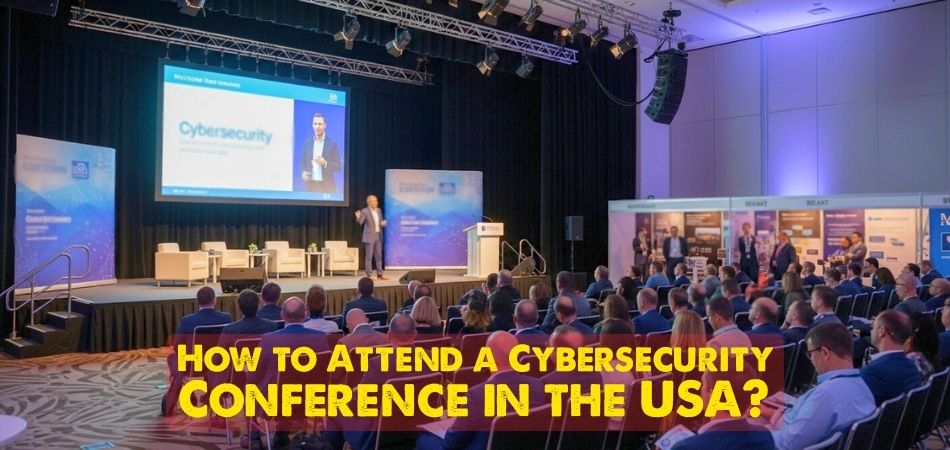Every year, cybersecurity conferences across the USA bring together experts, leaders, and innovators to tackle the latest digital threats and solutions. These events attract professionals from government, universities, and private companies, creating a hub for learning, networking, and exploring new technologies. If you’re someone planning to join one of these events, you might be unsure how to attend a cybersecurity conference in the USA?
To attend a cybersecurity conference in the USA, first choose a suitable event through platforms like Eventbrite, Global Conference Alliance Inc., or organizations like ISACA and ISC2. Then register early through the event’s official website, book your travel and hotel, check visa requirements if you’re from another country, and plan your schedule based on the sessions you want to attend.
If you are excited to learn about cybersecurity and want to understand each step, you will find all the necessary information here. This article covers everything you need, from choosing the best conference to making new connections and even what to do after the event. So stay with us.
How to Attend a Cybersecurity Conference in the USA?
Going to a cybersecurity conference in the USA can help you learn new things, meet experts, and understand new security problems and tools. But before you attend, there are some important steps to follow to make everything go smoothly. This section will show you the basics so you know what to do next.
Step 1: Find the Right Cybersecurity Conference
You can search trusted platforms like Global Conference Alliance Inc., Eventbrite, or cybersecurity societies (such as ISACA, ISC2, or SANS Institute) to find top cybersecurity conferences in USA that match your interests and goals. These sites provide details on keynote speakers, workshop topics, and conference formats. Look for events that align with your focus, such as ethical hacking, cloud security, incident response, or policy and compliance. Review agendas and speaker lists to ensure the conference supports your career and learning objectives.
Step 2: Register as Early as Possible
Once you’ve chosen the right cybersecurity conference, register immediately. Early registration typically means lower fees and first access to exclusive workshops, training sessions, or networking opportunities. Here’s how:
- Go to the conference’s official website.
- Select your ticket type (student, professional, government, etc.).
- Enter your personal and payment details.
- Upload any required credentials (such as a student ID or industry certification).
- Confirm registration and save your confirmation email and receipt.
Early registration secures your seat in popular sessions and can save you money.
Step 3: Arrange Travel and Accommodation
After registering, book your travel and hotel as soon as possible. In popular cities like Las Vegas, San Francisco, or Washington D.C., early bookings offer better rates and convenient locations near the conference venue. Many events partner with hotels for discounted rates, staying close saves commuting time and lets you attend early sessions or evening networking events. Check for flexible cancellation policies in case plans change. Also, don’t forget to arrange transport from the airport—Uber, Lyft, taxis, and rental cars are common options.
Step 4: Check Visa Requirements if Needed
If you’re attending from abroad, you may need a B-1 Business Visa for the conference. Here’s how:
- Check Requirements: Visit the U.S. Embassy website in your country to see if you need a visa for conferences.
- Prepare Documents: Gather your valid passport (with at least 6 months’ validity), DS-160 form, conference invitation or registration confirmation, financial statements, and documents showing ties to your home country.
- Apply for a Visa: Complete the DS-160 form online, pay the application fee, and schedule your embassy or consulate interview.
- Attend the Interview: Bring all documents, and be ready to explain your purpose for attending the cybersecurity conference.
Good preparation simplifies the visa process.
Step 5: Set Goals and Build Your Schedule
Before attending, define your objectives—do you want to learn about threat intelligence, network with cybersecurity leaders, or explore career opportunities? Review the event program and highlight must-see sessions, workshops, or demos. If a mobile app is available, use it to personalize your agenda and set reminders for top sessions.
Step 6: Grab Your Conference Badge Early
Whenever possible, pick up your badge early. Getting to the venue early allows you to get comfortable, avoid registration lines, and access expo halls or networking lounges. You can also connect with other attendees informally.
Step 7: Keep Active During Sessions
Make the most of the conference by engaging in presentations. Participate in Q&A sessions, ask insightful questions, and join breakout discussions. Don’t hesitate to introduce yourself to speakers or peers—these conversations can lead to future collaborations, mentorship, or new job prospects. Take notes (digital or handwritten) on key insights, contacts, and actionable ideas for follow-up.
Step 8: Follow Up After the Conference
Once the conference ends, don’t let the momentum fade. Follow up with the contacts you made; connect on LinkedIn, send a quick thank-you email, or share notes from a session you both attended. Review your notes and summarize key takeaways to share with your team or peers. If you attended any certification workshops or earned CPE credits, make sure to log them properly. Consider writing a short blog or LinkedIn post reflecting on what you learned—it reinforces your knowledge and builds your professional presence.
How Do You Know if You Are Attending the Right Cybersecurity Conference in the USA?
Picking the right cybersecurity conference in the USA can be fun, but it might also feel a bit confusing. There are many events, so it’s important to choose one that’s really worth your time. A good conference helps you learn, meet people, and see useful tools. Here are some simple ways to know if you’ve picked the right one.
Conference Topic Match
The first thing to check is if the conference matches what you’re interested in. Some events focus more on hacking, while others talk about data protection or security laws. Look at the schedule or website to see what sessions are planned. If most topics sound interesting to you, that’s a good sign. Make sure it’s not too far from what you want to learn.
Speakers and Experts
Take a look at the list of speakers. Are there well-known names or people from top tech companies? If the speakers are experienced and respected in cybersecurity, the conference will likely offer useful information. You can also search a few speaker names online to see their background. Good speakers often mean better sessions.
Hands-On Activities
Some conferences are just people talking on stage, but others include workshops or live demos. These hands-on activities help you learn by doing. If the conference has training sessions, labs, or real examples, it’s a great bonus. This makes it easier to understand how cybersecurity works in real life. Check the event page for any special sessions like this.
Crowd and Attendees
The people who go to the conference matter too. Knowing the ideal attendee for cybersecurity conferences in the USA helps you figure out if you’re going to the right event. Are there professionals, companies, or even beginners like you attending? If the crowd seems friendly and mixed, it’s easier to learn and meet others. Some websites or social pages show pictures or reviews from past events, so you can see who usually attends.
Location and Timing
Where and when the event happens also matters. A good location is easy to travel to and has places to stay nearby. If it’s during a busy time or far away, it might be stressful to attend. Look at the event dates and city to see if it fits your schedule. You want a conference that’s both exciting and easy to attend.
Reviews and Ratings
Always check what other people say about the event. You can find reviews on websites, forums, or even social media. If many people say the event was helpful and well-organized, that’s a great sign. Bad reviews or missing information could mean it’s not the best choice. Honest feedback from others can help you decide.
Cost and What You Get
Some conferences cost a lot, so make sure it’s worth it. Check what the ticket includes—like food, workshops, or access to all sessions. Compare it with other similar events to see if the price is fair. Sometimes, paying a bit more gives you a better experience. Just be sure you’re not paying for things you don’t need.
Are Conference Invitation Letters Necessary for Cybersecurity Conference Attendees?
Yes, conference invitation letters are sometimes necessary, especially for those coming from outside the United States to attend a cybersecurity event. Many U.S.-based conferences provide these letters to help with visa applications or to show official proof of attendance. They are not always needed for local attendees, but they can still be useful in special cases. If you’re unsure, it’s better to check with the event organizers ahead of time to avoid problems.
For international visitors, an invitation letter helps support your visa request and explains the reason for your travel to U.S. officials. It usually includes your name, conference details, organizer contact info, and sometimes your role at the event. This letter is not a visa by itself, but it is part of your full visa application. Without it, your visa request may take longer or even be denied in some cases.
Local attendees inside the USA don’t always need a formal invitation letter, but it can still help in some situations. Some companies or schools may ask for it as proof of your plan to attend a professional event. If you’re getting travel funds or leave approval, the letter shows that the event is real and official. Even when not required, having one can sometimes make things smoother for work or school purposes. Below is a sample of a conference invitation letter that attendees can get if they request:
Date:
[Day] [Month], [Year][Recipient’s Name]
[Recipient’s Address]Dear [Recipient’s Name],
On behalf of the [Conference Name] Organizing Committee, I’m pleased to invite you to our upcoming event. This letter serves as your official invitation to participate in this key gathering of cybersecurity professionals.
The conference, titled “[Conference Theme]”, will take place from [Start Day] [Month] to [End Day] [Month], [Year] in [City], USA. It brings together engineers, analysts, and IT leaders to discuss new technologies, share research, and explore real-world cybersecurity solutions.
We look forward to welcoming you and hope this invitation supports your visa application process. If you need additional information, feel free to contact us.
Yours sincerely,
[Your Name]
[Your Title]
[Conference Organizing Committee]
How Early Should You Start Planning for Your Conference Attendance?
Getting ready for a conference takes more than just buying a ticket and showing up. If you want a smooth experience, planning ahead really helps. Most people start preparing at least two or three months before the event begins. This gives you enough time to take care of everything without feeling rushed or stressed.
Booking your ticket early saves money and also gives you access to special sessions that fill up quickly. Flights and hotels also cost less when booked early, especially in busy cities. Some conferences partner with hotels and offer lower prices for early bookings. It’s also easier to get a good spot close to the venue if you plan ahead.
If you’re coming from another country, you should start planning even earlier than others. Getting a visa takes time, and missing documents can cause delays. You’ll need a passport, a visa form, and maybe an invitation letter from the conference. Starting early makes sure everything is ready before the event starts.
Does attending a cybersecurity conference in the USA cost a lot?
Some cybersecurity conferences in the USA can be expensive, but not all of them cost a lot. It depends on the event, location, and ticket type. Bigger conferences with well-known speakers often have higher ticket prices than smaller ones. Planning ahead can help you find better deals and save some money.
Besides the ticket, you also need to think about travel, food, and where you’ll stay. The cost of attending a cybersecurity conference in the USA can go up fast if you book things late. Choosing a hotel close to the event helps save time and transport money. Some events offer free meals or discounts for early registration too.
To spend less, look for student discounts or virtual passes if you don’t need to go in person. Sometimes companies or schools help pay the cost. You can also share rooms or use budget travel options to lower your expenses. Even if it costs a bit, many people say it’s worth it for the knowledge and connections. To give you an idea of where your money might go, here’s a quick table:
| Cost Item | Details | Estimated Cost (USD) |
| Conference Ticket | Varies by event type (standard, student, VIP, early bird) | $200 – $2,000 |
| Airfare | Depends on distance, time of booking, and airline choice | $150 – $1,200 |
| Hotel Accommodation | Typically 2–4 nights; near the venue or budget options | $300 – $800 |
| Local Transportation | Includes taxis, Uber/Lyft, public transport, or rental car | $50 – $200 |
| Meals and Snacks | For meals not provided at the conference | $75 – $200 |
| Travel Insurance | Optional but helpful for international attendees | $40 – $100 |
| Visa Application Fee | For international travelers needing a B-1 Business Visa | $185 |
| Internet or SIM Card | Temporary SIM or roaming plan for connectivity | $20 – $50 |
| Conference Materials | Notebooks, pens, badge holders, or branded items | $10 – $40 |
| Networking Events | Some events outside the main conference may require separate fees | $25 – $100 |
| Certification Workshop | Optional pre/post-conference training or exam sessions | $150 – $500 |
| Souvenirs and Extras | T-shirts, tech gear, or other personal purchases | $30 – $100 |
Things to Do If Your USA Conference Visa is Denied
Getting a visa to attend a conference in the USA is exciting, but things don’t always go as expected. If your visa gets denied, it can feel disappointing, especially after all your planning. But don’t worry—there are simple actions you can take. Read on to learn what you can do next.
Check the Reason
The first thing you should do is find out why your visa was denied. The embassy usually gives you a paper with the reason. Sometimes, the problem is missing documents or something in your application. Knowing the exact reason helps you understand what went wrong. This will make it easier to fix the next time.
Review Your Documents
Go through all the papers you sent with your visa application. Make sure nothing is missing or out of date. Check if your invitation letter, passport, and bank statements are correct. Sometimes, even small mistakes can cause a denial. Keeping your documents clear and complete can make a big difference.
Ask for Help
If you’re not sure what to do next, you can talk to someone with more experience. Conference organizers sometimes help by writing a new invitation letter or explaining your situation. You can also ask family or friends who have traveled before. There are travel agents or visa experts who can give good advice.
Prepare for Reapplication
You can try applying again, but only after fixing the problems found in your last application. Add any missing papers and make your answers very clear. Double-check all your forms before submitting them. Make sure to give the embassy any new information that supports your visit.
Stay in Touch with Organizers
Let the conference organizers know if your visa was denied. They might have tips or be able to extend your invitation. Sometimes, they can move your registration to next year or help with paperwork. Stay updated with them about any changes or support they can give.
Common Mistakes You Can Make When Registering for a Cybersecurity Conference in the USA
Registering for a cybersecurity conference in the USA sounds easy, but it’s common to miss a few small yet important steps. Mistakes during registration can cause stress or even stop you from joining the event. Knowing what to avoid can help you stay prepared.
- Using the Wrong Email: If you register with an old or incorrect email, you might miss your confirmation or updates about the event later.
- Missing the Early Deadline: Waiting too long to register often means paying higher fees and losing spots in limited workshops or training sessions.
- Choosing the Wrong Ticket Type: Picking a ticket that doesn’t match your role could block access to key sessions made for your level or background.
- Not Checking Event Location: Some conferences happen in different venues each year, and booking the wrong city can lead to big travel problems later.
- Skipping Terms and Rules: Ignoring refund or cancellation rules can cause trouble if your plans change and you need to cancel or reschedule attendance.
- Forgetting Required Documents: Some conferences ask for ID, student proof, or credentials, and missing them can delay or cancel your registration approval.
- Typing the Wrong Name: Spelling mistakes in your name may lead to issues with your badge or entry to the event on arrival.
- Not Saving Confirmation Info: Deleting your registration email by mistake can make it hard to show proof if any issues come up at the venue.
- Missing Add-On Sessions: Some workshops or lab tours need extra tickets, and forgetting to register for them early means missing out on good content.
- Overlooking Payment Details: Failing to complete your payment or entering the wrong card info can stop your ticket from being processed fully or on time.
What Happens After You Register for the Cybersecurity Conference in the USA?
The registration process for a cyber-security conference in the United States is just the beginning. After you sign up, there are still some things you should keep in mind. These actions will help you stay ready and make the most of the event. Here’s what happens after you register:
Confirmation Email
Once you register, you’ll get a confirmation email from the organizers. It will have your ticket, payment receipt, and event details. Always check your spam or junk folder in case the email doesn’t land in your inbox. Save that email safely because you might need it at the event.
Access to Conference App
Most big conferences have their own app or website login. You’ll get access after registering, sometimes with a personal code or link. This app lets you check the schedule, bookmark sessions, and see speaker names. It helps you plan your days better during the event.
Special Session Sign-Up
Some sessions, like hands-on workshops or training, need extra sign-ups. After registration, you may get an email asking you to choose them. These fill up fast, so don’t wait too long. Signing up early gives you better chances to join the ones you like.
Hotel and Travel Planning
Having secured your spot, it’s time to decide where to stay and how to get there. Some conferences offer hotel discounts, so check the official website. Booking early means cheaper prices and better locations. Don’t forget to plan how you’ll get from the airport as well.
Visa Support if Needed
If you’re coming from another country, the organizers may send you a visa invitation letter. This helps when applying for a visa at your local U.S. embassy. You usually need to request it by filling out a simple form. Always start this step early to avoid delays.
Pre-Event Emails
You might receive a few emails before the event starts. These could include reminders, speaker updates, or last-minute changes. Read them carefully so you don’t miss anything important. Sometimes they also include tips for what to bring or how to check in faster.
Badge Pickup and Entry
Many conferences offer early badge pickup a day before the event. This saves time on the first morning and helps you avoid long lines. Just bring your confirmation email and maybe a photo ID. Once you get your badge, you’re officially ready to go.
Tips for Booking Accommodation Near the USA-Based Cybersecurity Conference Venue
Finding a good place to stay near your cybersecurity conference in the USA can make the whole trip easier and more enjoyable. A nearby hotel saves time and helps you attend early sessions without stress. Use these simple tips to choose the right place to stay.
- Check Venue Distance: Look for hotels within walking distance so you won’t need a car or extra transport during your stay at the conference.
- Compare Hotel Deals: Visit travel websites to compare prices, reviews, and amenities before you book. Choose the one that gives you the best value.
- Book in Advance: Rooms near the venue fill up fast, especially during big events, so booking early helps you get better rates and options.
- Look for Conference Discounts: Some events offer special hotel rates through their website or partner hotels, so check for discount codes before paying full price.
- Read Guest Reviews: Always check guest reviews on trusted sites to avoid hotels with poor service, hidden charges, or cleanliness problems during your stay.
- Check for Free Perks: Pick hotels that offer free Wi-Fi, breakfast, or shuttle service—it saves money and makes your stay more comfortable and simple.
- Know the Cancellation Policy: Choose hotels with flexible cancellation in case your travel plans change, your visa is delayed, or the event gets moved.
- Consider Room Sharing: If you’re trying to save money, sharing a room with a friend or another attendee can cut hotel costs in half.
What to Do After the Cybersecurity Conference Ends?
Attending a cybersecurity conference is exciting, but once it ends, there are still a few things left to do. What you do after can be just as important as what you did during the event. Taking the right steps helps you remember what you learned and stay in touch with the people you met. Keep reading to learn what you should do after the event is over.
Organize Your Notes
Go through the notes you took during the sessions. Highlight the best tips, tools, or websites that you want to explore more. You can also group them by topic to make them easier to review. This way, you won’t forget the useful things you learned.
Connect with People
If you met people at the event, now’s the time to follow up. Send a short message or connect with them on LinkedIn. A simple “nice to meet you” note helps keep the connection alive. Staying in touch may help you later at work or on projects.
Review the Materials
Many conferences share recordings, slides, or extra files after the event. Check your email or the event website to find them. These are great for reviewing talks you missed or didn’t fully understand. Download and save them in one folder for easy access.
Log Certificates or Credits
If you got a certificate or earned any learning credits, be sure to save them. You might need them for school, work, or future events. Print a copy and also save one on your computer. Don’t wait too long, or you might forget.
Share What You Learned
Talk about the event with friends, team members, or on social media. You can also write a small post about your favorite session. Sharing helps you remember things better. It might also help others who didn’t attend the event.
Plan for the Next
If you enjoyed the conference, you might want to attend another one in the future. Make a list of topics you want to learn more about. Keep track of upcoming events that match your interests. This helps you grow step by step.
Commonly Asked Questions
After reading everything about attending a cybersecurity conference in the USA, you might still have a few questions in mind. Below are answers to some common questions that can help you better prepare, understand what to expect, and make your experience even smoother.
What Should I Wear to a Cybersecurity Conference?
Most cybersecurity conferences are business casual, but it’s best to dress neat and comfortable. You’ll be walking a lot and attending sessions all day, so wear something smart but practical. Closed shoes and a light jacket are good choices. You don’t need a suit unless a specific session or event asks for it.
Are Cybersecurity Conferences Safe to Attend?
Yes, most conferences are held in secure venues with staff and safety rules in place. Some even have badge checks or security at the entrance. You should still keep your personal items safe. Follow all event rules and ask staff if you feel unsure.
How Can I Meet New People at the Event?
To meet new people, try joining small discussions after a session or saying hello at lunch. Many attendees are open to chatting, especially during coffee breaks or at booths. You can also attend networking mixers or panels. A simple smile and introduction can go a long way.
Can I Attend the Cybersecurity Conference Without a Technical Background?
Yes, you can attend even without deep technical knowledge. Many sessions are designed for beginners or people new to cybersecurity. You’ll also find talks focused on policies, business, and general security awareness. Just pick the sessions that match your level of understanding.
How Long Does a Typical Cybersecurity Conference Last?
Most cybersecurity conferences last between two and four days. Some events may offer extra workshops before or after the main conference. These bonus sessions give extra learning opportunities. Make sure to check the full schedule so you don’t miss anything.
How Early Should I Arrive at the Venue?
It’s best to arrive at least 30–60 minutes early, especially on the first day. This gives you time to check in, get your badge, and find your way around. Some sessions fill up fast, so early arrival is a good idea. It also helps you relax before things begin.
Is There Any Help Desk at the Cybersecurity Conferences in the USA?
Yes, most Cybersecurity Conferences in the USA have a help or info desk near the main entrance. Staff there can answer questions, guide you to rooms, or help with badges. Don’t hesitate to ask for help—they’re there for you. It’s a good first stop if you’re unsure of something.
Final Thoughts
Visiting a cybersecurity conference in the USA is more than just showing up. It’s about preparing before the event, staying engaged, and making the most of it. Whether you’re flying in or driving across a few states, every step matters when you want to get the best out of your experience.
From choosing the right event and booking your hotel early, to joining sessions and following up afterward, each part plays a role in your success. If you’re serious about learning, meeting people, or even starting a career in this field, every detail adds up.
Now that you know how to attend a cybersecurity conference in the USA, you’re ready to take the next step. Plan ahead, follow the tips, and enjoy everything the event has to offer.









